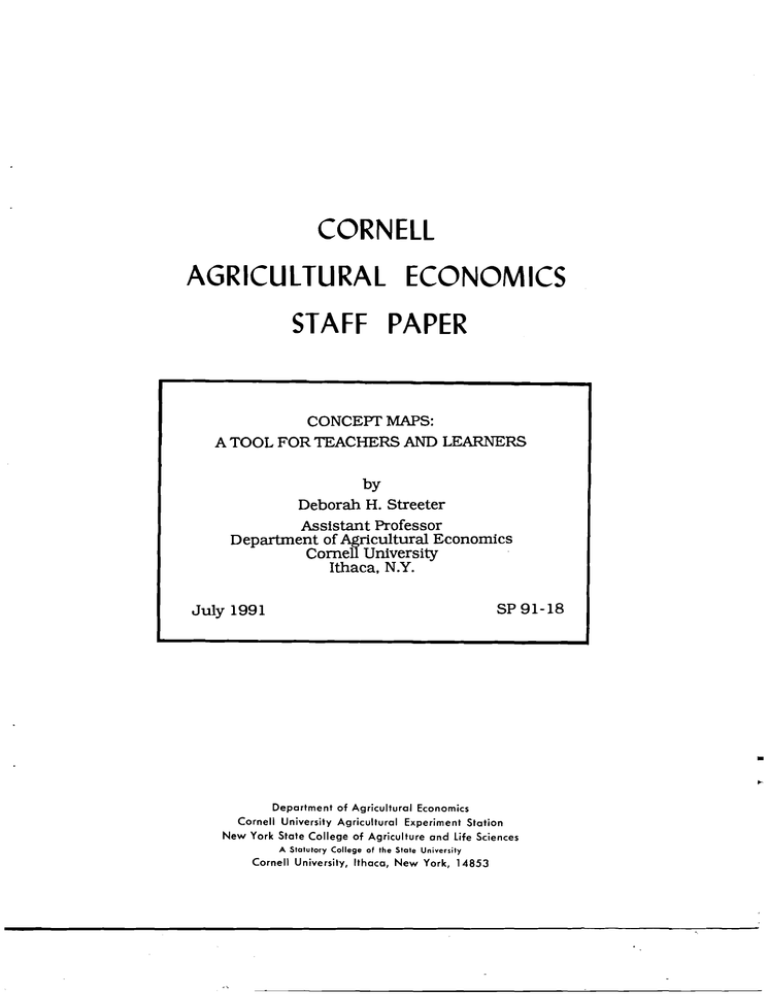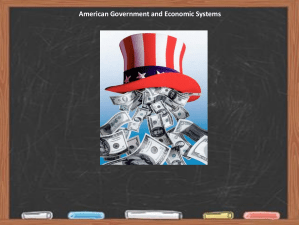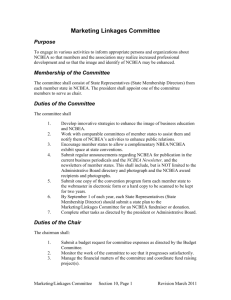Document 11951904
advertisement

CORNELL AGRICULTURAL ECONOMICS STAFF PAPER CONCEPT MAPS: A TOOL FOR TEACHERS AND LEARNERS by Deborah H. Streeter Assistant Professor Department of ~ricu1tural Economics Cornell University . Ithaca, N.Y. SP 91-18 July 1991 • Department of Agricultural Economics Cornell University Agricultural Experiment Station New York State College of Agriculture and Life Sciences A Statutory College of the Slate University Cornell University, Ithaca, New York, 14853 It is the policy of Cornell University actively to support equality of educational and employment opportunity. No person shall be denied admission to any educational program or activity or be denied employment on the basis of any legally prohibited dis­ crimination involving, but not limited to, such factors as race, color, creed, religion, national or ethnic origin, sex, age or handicap. The University is committed to the maintenance of affirmative action programs which will assure the continuation of such equality of opportunity. ~" Abstract Concept maps are a tool developed at Cornell University. designed for use as a metacognitive strategy. or a general strategy. that helps the student "learn how to learn." The goal of this paper is to illustrate how concept mapping can be used to integrate multidisciplinary subject maUer. assist the teacher in understanding the knowledge base of the student. reveal misconceptions or missing conceptual links. help resolve communications problems between the student and the professor. and encourage reflective thinking by all participants in the learning process. Three specific teaching situations are presented: 1) preparation of class materials. 2) communication with students in the classroom or the office. and 3) training of a teaching assistant. Examples of actual concept maps drawn by the author and her students are included. - Concept Maps: A Tool for Teachers and Learners 1 Deborah H. Streeter Department of ~ricultural Economics Cornell University Introduction It has been said that the primary detenninant of what students learn is what they already know (Ausubel, 1968). Yet, as teachers in economics and other fields, we typically focus on content, that Is, what facts and "knowledge" are to be imparted to our students. However, without a sound conceptual framework, students will be unable to internalize the content of lectures and materials. Memorization may be achieved, but meaningful learning will not be facilitated. Concept maps are a tool developed at Cornell University, designed for use as a metacognitive strategy, or a general strategy that helps the student "learn how to learn" (Novak and Gowin, 1984). Maps are constructed by linking concepts Oabels used to represent perceived regularities in events or objects) with connecting words (propositions or units of psychological meaning). Concept mapping evolved in response to the need for faculty to assess more carefully the conceptual knowledge initially held by the 'students and to monitor changes in that framework as learning proceeds. However, more broadly viewed, concept mapping can be used 1 This paper was presented by Deborah H. Streeter at the Conference on Teaching Economics: Instruction and Classroom­ Based Research, Robert Morris College, Pittsburgh, February 8-9, 1991. - 2 by teachers to articulate better their own conceptual framework. by students to analyze readings and other course materials. and by teaching assistants in communicating with the faculty and/or students. In previous research. concept mapping has been used to study assimilation of science concepts over time (Novak and Musonda). conceptual knowledge of primary grade children (Symington and Novak. 1982). reduction of anxiety in learners in Nigeria (Jegede. Alaiyemola and Okebukola. 1990). and curriculum development (Starr and Krajcik. 1990). More recently. Beissner (1991) showed that subjects who used concept mapping to study a text passage were better able to solve problems based on the passage than students who did not use concept mapping to study. The goal of this paper is to illustrate how concept mapping can be used to integrate multidisciplinary subject matter. assist the teacher in understanding the knowledge base of the student. reveal misconceptions or missing conceptual links. help resolve communications problems between the student and the professor. and encourage reflective thinking by all participants in the learning process. To achieve this goal. three specific teaching situations are presented in which the author made use of concept mapping: 1) preparation of class materials. 2) communication with students in the classroom or the office. and 3) training of a teaching assistant. The examples are drawn from a course and several independent study projects in the areas of decision analysis and information systems. This paper includes actual concept maps drawn by the author and her students and the discussion includes reflections on the advantages and drawbacks of the concept mapping tool. -. 3 More on Concept Maps A concept map is not an outline or a flow chart, but is a schematic device that uses visual imagery to show hierarchical relationships. Because concept maps are nonlinear by design, they can promote integrative and reflective thinking. Creating a concept map is an iterative process. The fIrst step is to write a list of the basic concepts and sketch out a map showing the primary relationships. The most general concepts should be at the top of the map, with less general concepts extending. Connective phrases and arrows are used to clarify the linkages. The fIrst step of a map of farm information systems is illustrated in Figure 1. Once the basic structure is in place, details and linkages are added to the map. For example, in Figure 2, the various fIelds contributing to the study of information system are added, and linkages between decision-making activities and information system advantages are made. The map now shows that while aspects like speed and timeliness impact implementation tasks, flexibility is important for planning tasks. Finally, cross linkages are added that might help integrate different areas of the map. Cross linkages in Figure 3 show the connections between decision-maker characteristics and decision-making. The map shows how the amount of human capital, time and money a manager has will affect the type of decision-making he or she can carry out. A fully developed concept map is found in Figure 4. Looking at this map about concept mapping, you can begin to see how relationships among ideas and concepts are communicated efficiently in a map. For example, this Single map illustrates the importance of prior knowledge in ­ 4 building concepts, the impact of cognitive structure on learning, the influence of context on the hierarchy of the map, and the use of propositions to make linkages and cross linkages. Three Real-World Applications 1. Preparing for class This example is drawn from the author's experience in designing an course in information systems and decision analysis. One difficulty in preparing materials and organizing the course was integrating material from many fields (economics, decision science, management science, computer science, operations research, psychology, and others) and choosing a course focus. Concept mapping helped achieve integration and provided a frame of reference throughout the course to keep the "big picture" in mind while concentrating on smaller individual areas. While many maps were drawn throughout the course, the map in Figure 4 is the highest level map, shOwing the interrelationship among the major course topics. The map reflects several important aspects. Notice that the decision maker is at the center of the map. This positioning reflects the author's viewpoint that in working with computer technology it is essential to maintain the pivotal role of the human thinker. In addition, in making and refining the map, it became clear that there are important linkages between Herbert Simon's stages of decision making and the various methodologies learned in the class. Thus, when presenting the section on forecasting, the author links it with the "intelligence" stage of decisions, where opportunities or problems are identified. - 5 When presented in class. the integrative map stimulated interest and controversy as students argued for different or additional linkages. or pointed out what they saw as missing concepts. Some thought that the three stages. which had been so heavily emphasized in class. should be at the center. with the decision maker at the top. Others wanted to see stronger linkages between the organizational levels and other parts of the map. Indeed. they revealed an area that had always been difficult to integrate. Eventually. discussion of organizational levels was deemphasized. as it did not easily link to other topics in the course. 2. Communicating with students In working with both graduate and undergraduate students the author has used concept maps to improve communication. For example, a foreign student was having persistent problems focusing his masters thesis. Language problems complicated the situation. Mter teaching the student about concept mapping. the author and the student independently drew concept maps to depict the thesis topic. Together. they were able to combine and refine a map that was agreeable to both. In another example, an undergraduate was having trouble explaining what he wanted to do in his independent study project. The concept map he drew was jumbled and had some incorrect conceptual links. By working through each part of the map. the student was able to focus more carefully and begin his research. In a third case, the author was working on an independent study project with two students. The project consisted of a directed readings course. in the area of futures markets. It became difficult to assess accurately whether the students understood every reading. because ­ 6 meeting times were limited to a few hours a week. When required to draw concept maps. the students could illustrate more easily their . knowledge of a particular reading. as illustrated in Figure 5. The map of an article on fmancial futures is actually a composite work of the students and the teacher. The map shown in Figure 6 was drawn by a student to demonstrate mastery over several chapters in a book about options markets. Within 20 minutes it became clear that the student was well prepared and was ready for more advanced material. 3. Training a teaching assistant A teaching assistant and the author were reviewing each section of a course to be taught jointly. The concept maps of the author served as a basis for discussion and eventually the teaching assistant began drawing his own concept maps. By sharing these conceptual frameworks. the teacher could be assured that the assistant was going into the classroom with a sound foundation. One of the maps drawn by the student is found in Figure 7. Several misconceptions were uncovered. such as the idea that the information used to revise probabilities (in a Bayesian analysis) is deterministic rather than probabilistic. In a previous map. the student omitted the linkage between risk and the probability estimates of the decision maker. Another missing linkage was identified between Bayesian Analysis and expected value of decision outcomes. Thus. the map was a useful tool for dialogue between teacher and student. - 7 Conclusion The primary conclusion drawn from the experience ofthe author in using concept mapping is that it is a useful tool for integration and communication. It can be helpful in organizing course lectures and lab materials, integrating concepts from different fields, focusing independent study projects, promoting teacher/student discussion on conceptual issues, and revealing new, missing or incorrect linkages. The tool has some limitations. Drawing maps and sharing with others takes time and practice. Moving from a nonlinear form to a linear (verbal) presentation requires skill. Motivating students to learn and use concept mapping can be a challenge initially. Using maps in a classroom setting takes considerable skill and requires that the students feel that they will not be punished for giving "wrong" answers. Workshop participants with small and large classes should fmd this topic of interest. Although in teaching economics, we tend to use mathematical or graphical relationships routinely to present concepts, students often have difficulty understanding all the conceptual relationships in a introductory or upper level economics course. Faculty interested in strengthening their own presentation of the conceptual framework, or assessing more clearly the student's conceptual framework, will fmd concept maps a useful and interesting technique. - References Ausubel, David P. (1968) Educational Psychology: A Cognitive View. New York: Hold Rinehart & Winston. Beissner, Katherine L. (1991) "A Study of the Effectiveness of Concept Mapping on Improving Problem Solving," presented at the Combined Sections meeting of the American Physical Therapy Association, Orlando. Jegede, Olugbemiro J., Folusho F. Alaiyemola and Peter A. O. Okebukola. (1990) ''TIle Effect of Concept Mapping on Students' Anxiety and Achievement in Biology." Journal of Research in Science Teaching. 27:10:951-60. Novak, Joseph D. and D. Bob Gowin. (1984) Learning How To Learn. New York: Cambridge Press. Novak, Joseph D. and Musonda, D. (in press). "A Twelve-Year Longitudinal Study of Science Concept Learning." American Education Research Journal Starr, Mary L. and Joseph S. Krajcik. (1990) "Concept Maps as a Heuristic for Science Curriculum Development: Toward Improvement in Process and Product." Journal of Research in Science Teaching. 27: 10:987-1000. SYIIlington, David and Joseph D. Novak. (1982) 'Teaching Children How to Learn," Educational Magazine. 39:5: 13-6. Wesley, Walter G. and Beverly A. Wesley. "Concept Mapping: A Brief Introduction," The Teaching Professor. October 1990. - a> a Figure 1 I ~ ~ C) ~anagement , Figure 2 SCie$ ,Scienc;$ ~mputer I l \ I f \ , , .'- eli Cl I .--..,-- !:!:'nagemcnt SCicn~ Figure 3 ............... --..._- --­ .,.,..,..",.",""- // I \ . I J J \ \ \ \ . Figure 4 ~roNtwrM~ reOeeu sbows depends on ~N1aTI d.pen~onJl increases Letween modifies are PRorOSlnONS ~ IIIERARCIlf orders • inOuences UNKS· CROSSUNKS Ilnll from are between MOST IMPORTANT PERCEIVED REGULARlnES OOGNlnVE STRUC1lJRES in in 10 10 designated by is either LEAST IMPORTANT c.£. e.g. I 1 MEMOIDZAnON Source; Wesley Ir-- --I and Wesley or I WORD e.g. I !sudIDLI -. - ~ Figure 5 , .... l-­ ( . ' ., d'l4l'Ocb j ttd bAt r CH to,; '-I) . , ·'I\'!»trvMe.nt C~n ~t~ ~~ r~h- umen-ls Qash Mk-t J., .... means t~ !An --~.-_. _ ~ .. bu.lj .. , , 0 . -"" ..,~~"'~ " '~" . .... 'R~ .'-_' .. __ .-.~~ ... ­ / .. ,I , I \ I, '.'-. '" // "'................ ""-'" ~ e.pecta11 I\q\ -,~. '~-'~'- i \ j " \ ...... on I sitton q , assets \ ~ s.n _ hi9l ....... ---~ - Buv Short LoW .... posi~ triK@o tabs~~~ &. Not• 'at a tr.;,;;;-----/ .,-. .;....,.,- --------- ~or< C~1Ior~ (!Ator~ t.s Iias~ Short t.,-m ~ r-~-5.cond--ary-M.tc--t-~ .conomic unit Claim on ~ higher when thert is mort txptctld to M -ddof $ •• derived from combining haircut repairs advice such as " "-.,.lo"'"----........ FNnoial ADm "" for: his 2I ~pH of mll'tcm elLS. ~---;'lOITrio ~stem) G\ CD 11 ~ ...."':I Figure 7 en CD o CD c:: °E .!: 0'" 0_ CD .!:(j) ,."..-",~_.-..... .. -. _--- assigns CD ~ (Track Record ) ........... ­ __._..__ . ._......_. . ,,' c. en t5 .......... (fI ~ S" States of Nature oe\e1. ~\(\e incorporates Payoff Matrix Decision Tree )---~ can be put in • Other Agricultural Economics Staxx Papers No. 91-6 Farm Structure: Concept and Dexinition B. F. Stanton No. 91-7 Recogni2ing the Exxects ox Government Programs in Developing Cost and Returns Statements B. F. Stanton No. 91-8 Price Formation and the Transmission ox Prices Across Levels ox Dairy Markets Andrev M. Novakovic No. 91-9 Outlook xor Nev York Farm Milk Prices With or Without an Emergency Order Andrev M. Novakovic No. 91-10 The Impact ox the Immigration Rexorm and Control Act ox 1986--IRCA--on Farm Labor Contracting Enrique E. Figueroa No. 91-11 Principles ox Institutionalist Research Methodology Mark Cohen No. 91-12 Bulgaria A Long and Winding Road to Democracy and a Market Economy - The Special Problems ox Agriculture Christo Petkov Dimo Dichev No. 91-13 The -Adirondack Dilemma- Mark Cohen No. 91-14 Heeded Rexorms in the Harmoni2ation ox U.S. Patent Lav William Lesser No. 91-15 Time-ox-Use Pricing xor Electric Pover: Implications xor the Hev York Dairy Sector--A Preliminary Analysis Mark C. Middagh No. 91-16 The Causes ox Economic Inexxiciencies in Nev York Dairy Farms Arthur C. Thomas Loren W. Tauer No. 91-17 Role ox the Non-Proxit Private Sector in Rural Land Conservation: Results xrom a Survey in the Hortheastern United States Nelson L. Bills Stephen Weir ­



